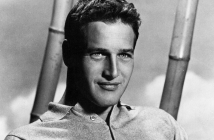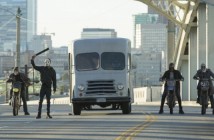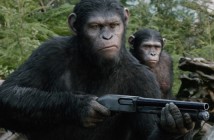Cinema is, among other things, an art of collaboration. Directors get the auteurist credit, but of course for most narrative films the actor’s presence is equally crucial. When an actor and a director get particularly in sync, they may decide to work together again in the future, and thus a continuing relationship is born; the best actor-director pairs may develop a fascinating consistency across many years of work together, doing their best work as a team rather than as individuals. Onscreen pairs like Lemmon and Matthau or Tracy and Hepburn may be more visible to the movie-going public, but a thorough study of history will show that a fruitful link between the personalities in front of and behind the camera, over multiple collaborations, can yield just as wondrous results. This week’s Top Ten Tuesday takes a look at the Top Ten Actor-Director Duos.
10. Vincent Price and Roger Corman
Collaborations: House of Usher (1960); The Pit and the Pendulum (1961); Tales of Terror (1962); The Raven (1963); The Haunted Palace (1963); The Masque of the Red Death (1964); The Tomb of Ligeia (1965).
The cycle of loose Edgar Allan Poe adaptations done by Roger Corman in the 1960s was undoubtedly his most fertile and accomplished period, thanks in no small part to the frequently witty, committed lead performances of Vincent Price. Amidst the relatively lavish sets and baroque color schemes stood Price’s dignified voice and theatrical bearing, regal and haughty but with more than a hint of incipient madness. Both men are inextricably linked to their low-budget Gothic tales of terror from this decade, and despite the wide breadth of work both Corman and Price did before and after, the continuity in style and performance makes them distinctive even fifty years later. In an interview last year with DreadCentral.com, Corman even noted that “Vincent’s performances made them [their films together]timeless pieces of art.”
9. Nobuko Miyamoto and Jūzō Itami
Collaborations: The Funeral (1984); Tampopo (1985); A Taxing Woman (1987); A Taxing Woman’s Return (1988); Tales of a Golden Geisha (1990); Minbo—or the Gentle Art of Japanese Extortion (1992); The Last Dance (1993); A Quiet Life (1995); Supermarket Woman (1996); Woman in Witness Protection (1997).
Husband and wife, the team of Miyamoto and Itami produced a series of satires on Japanese mores during the 1980s and 1990s. Miyamoto frequently played the underdog woman navigating the patriarchal authority of traditional institutions, ranging from the wannabe noodle maker in Tampopo to champions of the law fighting against corrupt tax-evaders and extorting gangsters to a histrionic actress/murder witness in their regrettably final collaboration before Itami’s untimely death. Miyamoto combined an attractive femininity with a gentle comic touch and flashes of grit as her heroines, beset by overwhelming odds but somehow ending up on top. Like in several other choices on my list to come, their off-screen relationship gave their collaborations an added dynamic, whether in adding or relieving tension, that allowed the actress to mine emotional territories perhaps impossible under other circumstances.
8. Anna Karina and Jean-Luc Godard
Collaborations: A Woman Is a Woman (1961); My Life to Live (1962); Le Petit Soldat (1963); Band of Outsiders (1964); Alphaville (1965); Pierrot le fou (1965); Made in U.S.A. (1966); Anticipation (1967).
The most recognizable female face of the French New Wave, with wide eyes, mysterious, sexy smile, and a black bob haircut, belonged to Anna Karina, Dutch model and lead actress for and one-time wife to director Jean-Luc Godard. Wry and unknowable to the many men who cross her path in the films, Karina’s persona mixed a playful, uninhibited sexuality, say in A Woman is a Woman and Pierrot le fou, with an altogether more despondent, introspective passion, most fully realized in My Life to Live, a veritable one-woman show. More than just a pretty face, she exuded a freewheeling thrill in tandem with her director’s cinematic adventurousness, always grounding the most esoteric, intellectual elements with graceful aplomb. The Godard-Karina films constitute the filmmaker’s best mix of experimental and commercial instincts, thanks in no small part to the actress’s alluring personality on screen.
7. Divine and John Waters
Collaborations: Roman Candles (1966); Eat Your Makeup (1968); Mondo Trasho (1969); Multiple Maniacs (1970); Pink Flamingos (1972); Female Trouble (1974); Polyester (1981); Hairspray (1988).
The Baltimore master of campy trash, John Waters, and his muse, female impersonator Divine (Harry Glenn Milstead), injected American cinema with a much-needed booster shot of bad taste in the 70s and 80s. Engaging in amusing debaucheries of religion, crime, and the media, Waters and Divine tore a swath through conventional morality and good taste in the name of a low-budget kitsch aesthetic. But beyond these lowbrow antics was a true desire to entertain, revealed most perfectly in his last two films for Waters, Polyester and Hairspray; especially in the latter, where Divine’s performances as Edna Turnblad and the TV station chief Arvin Hodgepile reveal to a wider audience the likeability and comic timing evident in the earlier, less commercial projects. For all of their outrageousness, Divine was an actor and John Waters is a director, with genuine technical skills and artistic senses.
6. Giulietta Masina and Federico Fellini
Collaborations: Variety Lights (1950); The White Sheik (1952); La Strada (1952); Il bidone (1955); Nights of Cabiria (1957); Juliet of the Spirits (1965); Ginger and Fred (1986).
The female analog for Charlie Chaplin, Giulietta Masina plays the childlike victim of comic fate in her first starring vehicles for husband Federico Fellini, eventually transitioning into a more emotionally complex woman with desires and a fuller inner life. The iconic Gelsomina of La Strada and Cabiria of Nights of Cabiria provide direct challenges to the uncaring, masculine world, embodied by Zampano the strong man in the former. Her optimism in the face of cruelty and ability to instill this feeling in others are parts of what make these films successful and lasting. Her two last performances for her husband, with her characters’ names in the titles, are no less fascinating for being a kind of feminine 8 1/2 on one hand, and an indictment of modern media superficiality on the other.
5. Ingrid Bergman and Roberto Rossellini
Collaborations: Stromboli (1950); Europa ’51 (1952); We, the Women (1953); Joan of Arc at the Stake (1954); Voyage in Italy (1954); Fear (1954).
The collaborations and love affair between Bergman and Rossellini famously began with a letter from her to him, hoping to work with him after having seen Paisan and Open City. Although probably best known for the controversy in America caused by their relationship and for their work’s poor box office performances, the five features together stand as intense expressionist/neorealist hybrids, quite unlike anything else in either one’s filmography. Characterized by emotional connections between character and landscape, the features of Stromboli, Europa ’51, and Voyage in Italy constitute a consistent “Bergman trilogy” that was basically only championed at the time by the French critics of Cahiers du Cinémai> and only reevaluated years later.
4. Jean-Pierre Léaud and François Truffaut
Collaborations: The 400 Blows (1959); Antoine and Colette (1962); Stolen Kisses (1968); Bed and Board (1970); Two English Girls (1971); Day for Night (1973); Love on the Run (1979).
The ultimate in alter-egoism is François Truffaut’s frequent protagonist Antoine Doinel, from troubled tyke in The 400 Blows to an even more fully-rounded figure, the subject of discussion by former loves twenty years later in Love on the Run. The novelistic structure of the so-called “Adventures of Antoine Doinel,” the rise and fall of personal fortune and drama in Antoine’s life, puts the series of films on a par with such middle-class mirrors as John Updike’s Rabbit books. Doinel, in his good and bad traits, reflects a self-examination on Truffaut’s part as well as a collaborative effort to universalize the particulars of an average but interesting Frenchman. In addition, Léaud played the young star in the film-within-a-film in Day for Night and the French Everyman in Two English Girls.
3. Klaus Kinski and Werner Herzog
Collaborations: Aguirre, the Wrath of God (1972); Nosferatu (1979); Woyzeck (1979); Fitzcarraldo (1982); Cobra Verde (1987).
I’m sure every pair on this list has had its disagreements, but I doubt any other collaboration featured one seriously considering a Peruvian chief’s proposal to kill the other. Legendarily misanthropic yet prolific, Kinski’s outbursts provided both fuel and frustration to his five epic films with Herzog, an altogether more quietly intense brooder. Usually playing a grim, isolated figure battling the forces of nature (although only in the Herzogian universe could Kinski ever represent civilization), Klaus is one of the great personalities on film, frothing and dangerous yet doomed to be crushed by the unfeeling world. The precarious, uncanny ambivalence between the two men is well documented by Herzog in My Best Fiend (1999).
2. Marlene Dietrich and Josef von Sternberg
Collaborations: The Blue Angel (1930); Morocco (1930); Dishonored (1931); Shanghai Express (1932); Blonde Venus (1932); The Scarlet Empress (1934); The Devil is a Woman (1935).
Bathed in the richest chiaroscuro, the legend of Marlene Dietrich emanates from the films of Josef von Sternberg. A master of the purely visual, he found the ultimate muse in the sultry Dietrich, a German-born singer and actress. There is much debate as to how much on screen was Dietrich and how much von Sternberg (as the director claims to have developed and more or less created her entire star persona by “discovering” Dietrich and utilizing her like a puppet), but their seven films together remain creative high points in their respective careers. Even if Lola-Lola from The Blue Angel was Dietrich’s only performance on film, she’d deserve at least a footnote in the history of seductive cinematic sirens. The baroque sets of The Scarlet Empress and overheated drama of so many of their collaborations find a remarkable analog in Dietrich’s haughtiness and exoticism, which was exploited later in her career only in the shadow of her von Stenberg films.
 1. Toshirō Mifune and Akira Kurosawa
1. Toshirō Mifune and Akira Kurosawa
Collaborations: Drunken Angel (1948); The Quiet Duel (1949); Stray Dog (1949); Scandal (1950); Rashomon (1950); The Idiot (1951); Seven Samurai (1954); I Live in Fear (1955); Throne of Blood (1957); The Lower Depths (1957); The Hidden Fortress (1958); The Bad Sleep Well (1960); Yojimbo (1961); Sanjuro (1962); High and Low (1963); Red Beard (1965).
One of the most charismatic of world actors, Toshirō Mifune became an icon of Japanese cinema thanks to his roles in the films of Akira Kurosawa. From his gruff period performances as bandits, samurai, and ronin to more contemporary roles as businessmen, cops, and criminals, Mifune had an exceptional range under Kurosawa’s tutelage. It was during the production of Red Beard that financial strains over Mifune having to grow and keep a beard (and thus could not change his appearance for other films during the shoot) led to an estrangement between the collaborators. Kurosawa/Mifune can be credited with influencing the Spaghetti western, Star Wars, and The Magnificent Seven, and providing one of the tensest, most hypnotic adaptations of Shakespeare ever put on screen.



